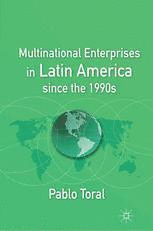
Multinational Enterprises in Latin America since the 1990s PDF
Preview Multinational Enterprises in Latin America since the 1990s
Multinational Enterprises in Latin America since the 1990s Multinational Enterprises in Latin America since the 1990s Pablo Toral multinational enterprises in latin america since the 1990s Copyright © Pablo Toral, 2011. Softcover reprint of the hardcover 1st edition 2011 978-0-230-10045-9 All rights reserved. First published in 2011 by PALGRAVE MACMILLAN® in the United States – a division of St. Martin’s Press LLC, 175 Fifth Avenue, New York, NY 10010. Where this book is distributed in the UK, Europe and the rest of the world, this is by Palgrave Macmillan, a division of Macmillan Publishers Limited, registered in England, company number 785998, of Houndmills, Basingstoke, Hampshire RG21 6XS. Palgrave Macmillan is the global academic imprint of the above companies and has companies and representatives throughout the world. Palgrave® and Macmillan® are registered trademarks in the United States, the United Kingdom, Europe and other countries. ISBN 978-1-349-28662-1 ISBN 978-0-230-11932-1 (eBook) DOI 10.1057/9780230119321 Library of Congress Cataloging-in-Publication Data Toral, Pablo, 1971– author. Multinational Enterprises in Latin America since the 1990s / Pablo Toral. p. cm 1. International business enterprises—Latin America. 2. Privatization— Latin America. 3. Investments, Spanish—Latin America. I. Title. HD2810.5.T66 2011 338.8'888—dc22 2010049482 A catalogue record of the book is available from the British Library. Design by MPS Limited, A Macmillan Company First edition: June 2011 “A Zuce” Contents List of Tables ix List of Figures xi Acknowledgments xiii Acronyms xv 1 Introduction 1 2 Theoretical Considerations and Development of the Model 17 3 Banking 31 4 Telecommunications 65 5 Public Utilities 95 6 Oil and Natural Gas 121 7 Conclusions 151 Notes 169 Bibliography 205 Index 229 List of Tables 1.1 F DI outward stock, million US dollars at current prices in 2007 2 1.2 Top multinationals in the world, 2006 4 3.1 Main subsidiaries of Spanish banks in Latin America, 2008 44 3.2 Effi ciency indicators 53 3.3 A ppreciation of stock for a selected group of banks, Dec. 31, 1995–Dec. 31, 2009 64 4.1 Telefónica’s main subsidiaries in Latin America in 2009 79 4.2 T elefónica’s ownership in a group of selected Latin American fi rms 81 4.3 A ppreciation of stock for a selected group of telephone operators, Dec. 31, 1997–Dec. 31, 2009 93 5.1 Main acquisitions of Spanish utilities in Latin America 104 5.2 G eneration capacity added by Spanish utilities in Latin America until 2009, in MW 110 5.3 Average annual shareholder return, 1998–2006 119 6.1 Repsol’s main acquisitions in Latin America 133 6.2 R epsol-YPF net production of oil and gas by region (thousands of barrels of oil equivalent—BOEs) 137 6.3 Appreciation of stock, Dec. 31, 1991–Dec. 31, 2009 150 List of Figures 1.1 I nward FDI fl ows in Latin America and the Caribbean, 1992–2004 (billions of dollars) 2 2.1 Development and application of the advantage 26 Acknowledgments I wish to thank Eduardo Gamarra, Félix Martín, Nicholas Onuf, and Mira Wilkins at Florida International University (FIU) and Elisabeth Prügl at the Graduate Institute in Geneva for reading several drafts and providing thoughtful suggestions. Four anonymous reviewers from Palgrave-Macmillan made insightful comments and suggested ways to improve the manuscript. Without a doubt, this book is more solid thanks to their valuable observa- tions. I also wish to thank Ralph Clem and Joaquín Roy at the University of Miami for their help to secure funding and for inviting me to present my work at the Miami European Union Center. Several friends read differ- ent parts of the manuscript and provided useful guidance: Arghyris Arghyrou (Montverde Academy), Roberto Domínguez (Suffolk University), César Francis (Universidad del Pacífi co), Aart Holtslag (University of Massachusetts-Lowell), Renzo Honores (High Point University), Sandro Patrucco (Universidad Católica del Perú), Sebastián Royo (Suffolk University), and Laura Zanotti (Virginia Tech). Universidad Católica del Perú and Universidad del Pacífi co in Lima gave me access to their collections. I am particularly thankful to Felipe Portocarrero and Cynthia Sanborn at the Centro de Investigación de la Universidad del Pacífi co in Lima and Aldo Panfi chi at Universidad Católica del Perú for giving me an offi ce and a computer to work. Omar Awapara, Gabriela Camacho, and Eduardo Dargent at Universidad Católica made sure I had everything I needed. I am also indebted to the students at Universidad Católica and Centro Bartolomé de las Casas in Cusco for their support and comments. Their suggestions helped me see Spanish multina- tionals in a broader sociopolitical context. The following institutions provided generous funding for my research: the Mouat Chair and the Dean’s Offi ce at Beloit College, the Department of International Relations, the Offi ce of the Dean of Arts and Sciences, the Center for Transnational and Comparative Studies (TCS), the Latin American and Caribbean Center (LACC) and the Graduate Student xiv ● Acknowledgments Association (GSA) at FIU, the Miami European Union Center (Miami EUC), Fundación para el Desarrollo de la Formación en las Zonas Mineras del Carbón (funded by the European Union and the governments of Spain and Asturias), the Library Travel Grants of the Center for Latin American Studies at the University of Florida, the Minda de Gunzburg Center for European Studies and the David Rockefeller Center for Latin American Studies at Harvard University. My sincerest thanks go to the interviewees, who gave me their time and attention. I also wish to thank the Dirección General de Comercio e Inversiones at the Spanish Ministry of Industry, Tourism and Trade and the seven Spanish multinationals included in this study for sharing information. My sincerest thanks also go to students and colleagues at Beloit College for their endless support.
